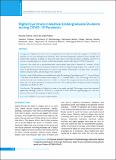Please use this identifier to cite or link to this item:
https://hdl.handle.net/20.500.14356/975| Title: | Digital Eye Strain in Medical Undergraduate Students during COVID-19 Pandemic |
| Authors: | Shrestha, Priyanka Pradhan, Pranil Man Singh |
| Citation: | ShresthaP., & Singh PradhanP. M. (2023). Digital Eye Strain in Medical Undergraduate Students during COVID-19 Pandemic. Journal of Nepal Health Research Council, 20(3), 726-730. https://doi.org/10.33314/jnhrc.v20i3.4275 |
| Issue Date: | 2022 |
| Publisher: | Nepal Health Research Council |
| Keywords: | COVID- 19 eye strain medical students |
| Series/Report no.: | July-Sep, 2022;4275 |
| Abstract: | Abstract Background: Digital devices have been an integral part of our daily lives. With the emergence of COVID-19 pandemic we have gone through strict lockdowns. Most educational institutions conducted classes virtually. This increased the symptoms of digital eye strain. This study aims to assess the prevalence, symptoms, and level of awareness regarding digital eye strain in medical undergraduate students following the COVID-19 pandemic. Methods: Our study was a questionnaire-based cross-sectional study with a duration of 3 months. All the undergraduate medical students studying at Kathmandu Medical College Teaching Hospital were included in the study. A self-administered questionnaire was sent to each student electronically via google forms. Descriptive statistics, frequency tables, and percentages were calculated. Results: A total of 208 students were included in the study. The mean age of participants was 22.7±1.6 years (Mean ± SD) with a mean duration of online classes being11.39 ± 5.2 months (Mean ± SD) . The average screen time of students before the start of online classes was 4.14 (SD=2.13) hours. The average screen time after the start of online classes was 7.93 (SD=2.44) hours, an increase of 91.54%. The overall prevalence of digital eye strain among the respondents was 90.8% (n=189). Conclusions: The prevalence of digital eye strain in our study was high. The average screen time increased significantly following COVID-19. Therefore, it is important to create awareness regarding digital eye strain and practices that decrease the symptoms of digital eye strain. Keywords: COVID- 19; eye strain; medical students. |
| Description: | Original Article |
| URI: | http://103.69.126.140:8080/handle/20.500.14356/975 |
| ISSN: | Print ISSN: 1727-5482; Online ISSN: 1999-6217 |
| Appears in Collections: | Vol 20 No 3 Issue 56 july-Sep, 2022 |
Files in This Item:
| File | Description | Size | Format | |
|---|---|---|---|---|
| 4275-Manuscript-30783-1-10-20230314.pdf | fulltext download | 186.97 kB | Adobe PDF |  View/Open |
Items in DSpace are protected by copyright, with all rights reserved, unless otherwise indicated.
